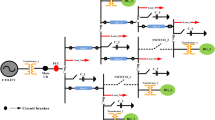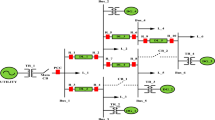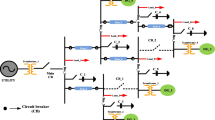Abstract
This work focuses on the protection of distributed generation (DG) integrated microgrid system by using Kernel Extreme Learning Machine (KELM) based Hilbert–Huang Transform (HHT). Firstly, the current signals collected from buses are processed through Empirical Mode Decomposition (EMD) to obtain the Intrinsic Mode Functions (IMFs). Subsequently, the most significant IMF is used for the calculation of spectral energy and differential energy of both the buses. Subsequently, the most relevant features for protection aspects like differential energy levels, mean, median, entropy, and standard deviation are recorded for all fault types in a grid-connected environment with both radial and looped structures on IEC microgrid model test system. Further, the Gaussian kernel is used with 70% data points for the training of the neural network and optimization of the random matrix. The optimized values are then analyzed for validation and the efficiency quotient. The accuracy, security, and dependability values clearly illustrate the superiority of this optimized KELM architecture for the detection of a fault in a grid-connected microgrid system.
Access this chapter
Tax calculation will be finalised at checkout
Purchases are for personal use only
Similar content being viewed by others
References
Sarangi S, Sahu BK, Rout PK (2020) Distributed generation hybrid AC/DC microgrid protection: a critical review on issues, strategies, and future directions. Int J Energy Res 44(5):3347–3364
Tan C, Ramachandaramurthy VK (2010) Novel wide area fault type classification technique
Karimi H, Nikkhajoei H, Iravani R (2007) A linear quadratic Gaussian controller for a stand-alone distributed resource unit-simulation case studies. In: 2007 IEEE power engineering society general meeting, pp 1–6
Patnaik B, Mishra M, Bansal RC, Jena RK (2020) AC microgrid protection–a review: Current and future prospective. Appl Energy 271:115210
Dehghani M, Khooban MH, Niknam T (2016) Fast fault detection and classification based on a combination of wavelet singular entropy theory and fuzzy logic in distribution lines in the presence of distributed generations. Int J Electr Power Energy Syst 78:455–462
Kanakasabapathy P, Mohan M (2015) Digital protection scheme for microgrids using wavelet transform. In: 2015 IEEE international conference on electron devices and solid-state circuits (EDSSC), pp 664–667
Parikh UB, Bhalja BR, Maheshwari RP, Das B (2007) Decision tree based fault classification scheme for protection of series compensated transmission lines. Int J Emerg Electr Power Syst 8(6)
Samantaray SR, GezaJoos, Kamwa I (2012) Differential energy based microgrid protection against fault conditions. In: 2012 IEEE PES innovative smart grid technologies (ISGT), pp 1–7. IEEE
Kar S, Samantaray SR (2014) Time-frequency transform-based differential scheme for microgrid protection. IET Gener Transm Distrib 8(2):310–320
Gururani A, Mohanty SR, Mohanta JC (2016) Microgrid protection using Hilbert–Huang transform based-differential scheme. IET Gener Transm Distrib 10(15):3707–3716
Mishra M, Rout PK (2017) Detection and classification of micro-grid faults based on HHT and machine learning techniques. IET Gener Transm Distrib 12(2):388–397
Huang NE (2014) Hilbert-Huang transform and its applications, vol 16. World Scientific
Huang NE, Wu Z (2008) A review on Hilbert‐Huang transform: method and its applications to geophysical studies. Rev Geophys 46(2)
Yi-bing L, Wu Q, Ma Zy, Yan K-g (2006) An improved Hilbert-Huang transform and its application in faults signal analysis. In: 2006 international conference on mechatronics and automation, pp 2426–2431. IEEE
Osman S, Wang W (2019) A new Hilbert-Huang transform technique for fault detection in rolling element bearings. In: Predictive maintenance in dynamic systems. Springer, Cham, pp 207–230
Navot A, Shpigelman L, Tishby N, Vaadia E (2006) Nearest neighbor based feature selection for regression and its application to neural activity. In: Advances in neural information processing systems, pp 996–1002
Huang G-B, Zhu Q-Y, Siew C-K (2006) Extreme learning machine: theory and applications. Neurocomputing 70(1–3):489–501
Huang G-B, Wang DH, Lan Y (2011) Extreme learning machines: a survey. Int J Mach Learn Cybern 2(2):107–122
Li G, Niu P (2013) An enhanced extreme learning machine based on ridge regression for regression. Neural Comput Appl 22(3–4): 803–810
Mishra M, Panigrahi RR, Rout PK (2019) A combined mathematical morphology and extreme learning machine techniques based approach to micro-grid protection. Ain Shams Eng J 10(2):307–318
Huang G-B, Zhou H, Ding X, Zhang R (2011) Extreme learning machine for regression and multiclass classification. IEEE Trans Syst Man Cybern Part B (Cybern) 42(2):513–529
Wong CM, Vong CM, Wong PK, Cao J (2016) Kernel-based multilayer extreme learning machines for representation learning. IEEE Trans Neural Netw Learn Syst 29(3):757–762
Author information
Authors and Affiliations
Corresponding author
Editor information
Editors and Affiliations
Appendix
Appendix
-
1.
Utility: rated voltage = \(120 \,{\text{kV}}\), \(f = 60\,{\text{Hz}}\), three-phase rated short-circuit = \(1000\,{\text{MVA}}\), base voltage = \(120 \,{\text{kV}}\), \(X/R\) ratio = \(10\).
-
2.
Transformers:
TR_1: rated \({\text{MVA}} = 15 \,{\text{MVA}}\), \(f = 60 \,{\text{Hz}}\), rated \({\text{kV}} = 120 \,{\text{kV}} / 25\, {\text{kV}}\), \(R1\) = \(R2 = 0.00375 \,{\text{pu}}, L1 = L2 = 0.1\, {\text{pu}}\), \(R_{\text{m}}\) = \(500\, {\text{pu}}\), \(X_{\text{m}}\) = \(500\, {\text{pu}}\).
TR_2 and TR_5: rated \({\text{MVA}} = 12\,{\text{MVA}}\), \(f = 60 \,{\text{Hz}},\) rated \({\text{kV}} = 2.4\, {\text{kV}} / 25\, {\text{kV}}\), \(R1 = R2 = 0.00375\, {\text{pu}}, L1 = L2 = 0.1\, {\text{pu}}\), \(R_{\text{m}}\) = \(500 \,{\text{pu}}\), \(X_{\text{m}}\) = \(500\, {\text{pu}}\).
TR_3: rated \({\text{MVA}} = 12 {\text{MVA}}\), \(f = 60 \,{\text{Hz}}\), rated \({\text{kV}} = 575\, {\text{V}}/ 25\, {\text{kV}}\), \(R1 = R2 = 0.00375 \,{\text{pu}}, L1 = L2 = 0.00375\, {\text{pu}}\), \(R_{\text{m}}\) = \(500 \,{\text{pu}}\), \(X_{\text{m}}\) = \(500\, {\text{pu}}\).
TR_4: rated \({\text{MVA}} = 10 {\text{MVA}}\), \(f = 60\, {\text{Hz}}\), rated \({\text{kV}} = 575\, {\text{V}}/ 25 {\text{kV}}\), \(R1 = R2 = 0.00375 \,{\text{pu}}, L1 = L2 = 0.00375\, {\text{pu}}\), \(R_{\text{m}}\) = \(500\, {\text{pu}}\), \(X_{\text{m}}\) = \(500\, {\text{pu}}\).
-
3.
Distribution Lines: DL_1, DL_2, DL_3, DL_4, DL_5: \(f = 60 \,{\text{Hz}}, r1 = 0.125\, \varOmega /{\text{km}}, r0 = 0.447\, \varOmega /{\text{km}}, l1 = 1.1e - 3 H/{\text{km}}, l0 = 3.47e - 3 H/{\text{km}}\), \(c1 = 10.1766e - 9\,{\text{F}}/{\text{km}}, c0 = 4.5e - 9{\text{F}}/{\text{km}}\), Line length = 30 km each.
-
4.
Loads: L_1, L_2, L_3, L_4, L_5, L_6: rated voltage = \(25\, {\text{kV}}\), \(f = 60 \,{\text{Hz}}\), Total active power = \(24\,{\text{MW}}\), Total inductive reactive power = \(12\,{\text{MVAR}}\).
-
5.
Distributed Generation:
-
DG_1, DG_4: (Synchronous generator) rated \({\text{MVA}} = 9\,{\text{MVA}}\), rated voltage = \(2.4\,{\text{kV}}\), \(f\) = 60 Hz, Xd = 1.56 pu, \(X_{\text{d}}^{\prime}\) = \(0.296\,{\text{pu}}\), \(X_{\text{d}}^{\prime\prime}\) = \(0.177\,{\text{pu}}\), \(X_{\text{q}}\) = \(1.06\,{\text{pu}}\), \(X_{\text{q}}^{\prime\prime}\) = \(0.177\,{\text{pu}}\), \(X_{l}\) = \(0.052\,{\text{pu}}\), \(T_{\text{d}}^{\prime}\) = \(3.7\,{\text{s}}\), \(T_{\text{d}}^{\prime\prime}\) = \(0.05\,{\text{s}}\), \(T_{\text{qo}}^{\prime\prime}\) = \(0.05\,{\text{s}}\), \(R_{\text{s}}\) = \(0.0036 \,{\text{pu}}\), \(H\) = \(1.07\,{\text{s}}\), \(F\) = \(0.1 \,{\text{pu}}\), \(p\) = \(2\).
-
DG_2: (Synchronous generator and full-scale converter (Type 4) detailed model wind farm) rated \({\text{MVA }} = 6\,{\text{MVA}}\), rated voltage = \(575\,{\text{kV}}\), \(f = 60\,{\text{Hz}}\), \(X_{\text{d}} = 1.305 \,{\text{pu}}\), \(X^{\prime}_{\text{d}}\) = \(0.296\,{\text{pu}}\), \(X^{\prime\prime}_{\text{d}}\) = \(0.252\,{\text{pu}}\), \(X_{\text{q}}\) = \(0.474 \,{\text{pu}}\), \(X^{\prime\prime}_{\text{q}}\) = \(0.243\,{\text{pu}}\), \(X_{l}\) = \(0.18\,{\text{pu}}\), \(T^{\prime}_{\text{do}}\) = \(4.49\,{\text{s}}\), \(T^{\prime\prime}_{\text{do}}\) = \(0.0681\,{\text{s}}\), \(T^{\prime\prime}_{\text{q}}\) = \(0.0513\,{\text{s}}\), \(R_{\text{s}}\) = \(0.006 \,{\text{pu}}\), \(H\) = \(0.62\,{\text{s}}, F = 0.1, p = 1\)
-
DG_3: (DFIG based wind farm) rated \({\text{MVA}} = 9\,{\text{MVA}}\), rated voltage = \(575\,{\text{kV}}\), \(f = 60\,{\text{Hz}}\), \(R_{\text{s}}\) = \(0.023\,{\text{pu}}\), \(Lls = 0.18\,{\text{pu}}\), \(Rr{\prime} = 0.0016\,{\text{pu}}\), \(Llr{\prime} = 0.16\,{\text{pu}}\), \(L_{\text{m}}\) = \(2.9\,{\text{pu}}\), \(H = 0.685\,{\text{s}}, F = 0.01, p = 3\)
-
Rights and permissions
Copyright information
© 2021 The Editor(s) (if applicable) and The Author(s), under exclusive license to Springer Nature Singapore Pte Ltd.
About this paper
Cite this paper
Sarangi, S., Sahu, B.K., Rout, P.K. (2021). An Optimized Machine Learning-Based Time-Frequency Transform for Protection of Distribution Generation Integrated Microgrid System. In: Sharma, R., Mishra, M., Nayak, J., Naik, B., Pelusi, D. (eds) Green Technology for Smart City and Society. Lecture Notes in Networks and Systems, vol 151. Springer, Singapore. https://doi.org/10.1007/978-981-15-8218-9_33
Download citation
DOI: https://doi.org/10.1007/978-981-15-8218-9_33
Published:
Publisher Name: Springer, Singapore
Print ISBN: 978-981-15-8217-2
Online ISBN: 978-981-15-8218-9
eBook Packages: Intelligent Technologies and RoboticsIntelligent Technologies and Robotics (R0)




